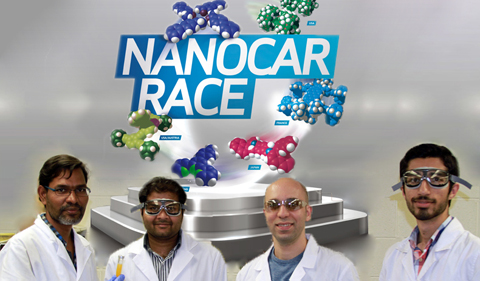
Nanocar graduate students Karthi Perumal, Kondalarao Kotturi, Mersad Raesi and Ramin Rabbani
“Six teams from three continents are preparing for a unique race on a polished gold track in the south of France this month. But this is no luxurious supercar event: competitors will be racing single molecules. In 36 hours, they aim to move them a distance of 100 nanometres — about one-thousandth the width of a human hair — on a laboratory track held in a vacuum and chilled to a few degrees above absolute zero,” writes Davide Castelvecchi in Nature.
The contest is being billed as the world’s first nanocar race, and the aim is to get people excited about nanotechnology and molecular machines, says co-organizer Christian Joachim, a chemist who works at the Centre for Materials Elaboration and Structural Studies in Toulouse, where the event will take place. He and Gwénaël Rapenne, a chemist at the University of Toulouse-Paul Sabatier, developed the contest after Joachim realized — following an interview with a journalist — that nanocars attracted much more public attention than did his research on fundamental aspects of nanotechnology….
Driving with electrons
The term nanocar is actually a misnomer, because the molecules involved in this race have no motors. (Future races may incorporate them, Joachim says.) And it is not clear whether the molecules will even roll along like wagons: a few designs might, but many lack axles and wheels. Drivers will use electrons from the tip of a scanning tunnelling microscope (STM) to help jolt their molecules along, typically by just 0.3 nano-metres each time — making 100 nanometres “a pretty long distance”, notes physicist Leonhard Grill of the University of Graz, Austria, who co-leads a US–Austrian team in the race.
Contestants are not allowed to directly push on their molecules with the STM tip. Some teams have designed their molecules so that the incoming electrons raise their energy states, causing vibrations or changes to molecular structures that jolt the racers along. Others expect electrostatic repulsion from the electrons to be the main driving force. Waka Nakanishi, an organic chemist at the National Institute for Materials Science in Tsukuba, Japan, has designed a nanocar with two sets of ‘flaps’ that are intended to flutter like butterfly wings when the molecule is energized by the STM tip (see ‘Molecular race’). Part of the reason for entering the race, she says, was to gain access to the Toulouse lab’s state-of-the-art STM to better understand the molecule’s behaviour.
Eric Masson, a chemist at Ohio University in Athens, hopes to find out whether the ‘wheels’ (pumpkin-shaped groups of atoms) of his team’s car will roll on the surface or simply slide. “We want to better understand the nature of the interaction between the molecule and the surface,” says Masson.


















Comments